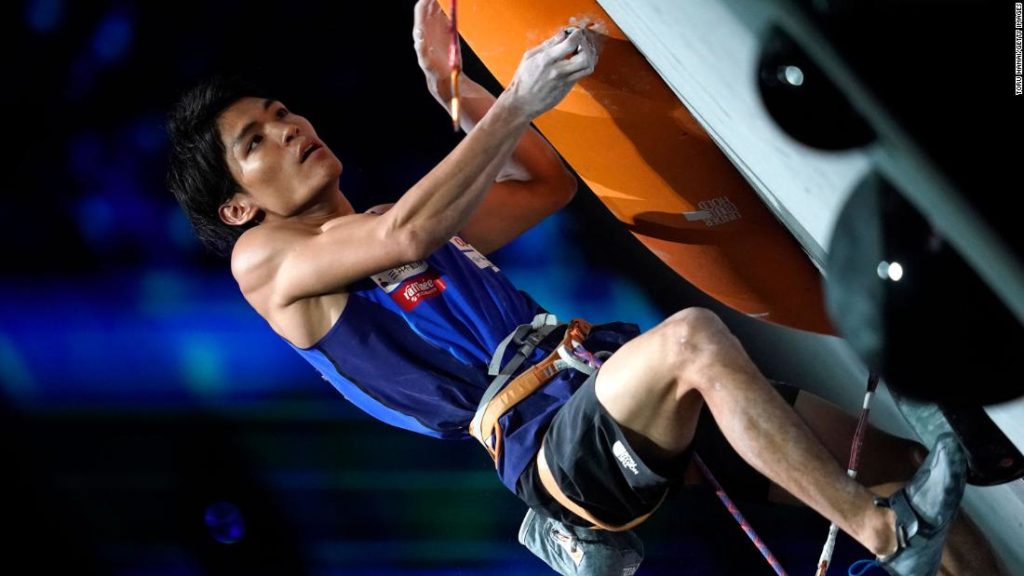And to better understand and enjoy these sports, casual viewers may need to learn some new sports terms.
While each sport has its own loyal following outside the Games, casual Olympics fans may not be very familiar with the specific terminology associated with these events.
Nicholas Watanabe, an associate professor in sports and entertainment management at the University of South Carolina, said that as someone who’s half Japanese and practices a Japanese martial art, he’ll be comfortable watching events like karate.
“But for the common lay person who hasn’t had these experiences, they’re just going to have no idea” what some of the terms mean, he said.
Experts with language-learning app Babbel compiled a list of terms associated with sports like karate and climbing, which both have events debuting at the Games this week, to help viewers keep up.
Sport climbing terms
Common phrases you might hear mentioned across the three events include:
Problem: A climber’s term for a bouldering route.
Crux: The crux of a climbing route is considered its most difficult section.
Crimp: A small climbing hold, done by wrapping the thumb over the index finger in a kind of pinching motion.
Bridging: A climber in a corner might spread their legs so that each foot touches a separate wall. A bridge refers to a climber’s legs, and bridging refers to the act of balancing by doing the splits.
Dyno: Short for dynamic, it describes a difficult move that involves jumping between holds and breaking contact with the wall completely.
Deadpoint: The moment in a dynamic move where the climber grabs a hold while moving between upwards acceleration and falling back down to the ground.
Flag: Sticking a leg out against a wall for balance.
Smearing: A climbing move that employs the wall, rather than holds, on a route. It involves smearing a foot down a wall to gain momentum in the absence of a foothold.
Pumped: A sign that a climber is weakened or in pain. It refers to bulging forearms that are pumped full of blood during a more grueling climb.
Karate terms
Karate’s debut at the Tokyo Olympics will pay homage to its cultural roots in Okinawa, an island region of Japan. It will feature athletes competing in two events: Kata, which means “form,” and Kumite, which refers to sparring.
Some of the moves in Kata, which is judged based on a competitor’s form, include:
Saifa Kata: This translates to “to smash and tear” in English. It involves tearing oneself from an attacker’s grip, then countering with punches, back fists, and hammer fists.
Chinto Kata: This means “crane on the rock.” This move uses a one-legged stance, resembling the one of the spindly bird, about to strike.
Chinte: This translates to “unusual hands” or “incredible hands,” and it gets its name from hand techniques, including defenses involving the use of elbows, spear hands, and palm strikes.
Here are some terms for Kumite, where two people spar against each other:
Shobu Hajime: This means the start of a karate match.
Yame: This means “stop,” usually for an interruption mid-match or at the end of the match.
Tsuzkete: This phrase roughly translates to “fight on.” It can be used after an official stoppage or informally if the referee feels that the fighters have been inactive for too long.
Aka (Ao) No Kachi: This signals a win at the end of a match. The referee extends their arm up on the side of the winner.
Skateboarding terms
Deck: The flat part of the skateboard a rider stands on.
Bail: When a skateboarder falls or decides in mid-air to not land a trick.
Bank: Any kind of incline used for a trick.
Fakie: Skating backwards.
Goofy-footed: Riding with the right foot at the front of the board (instead of the left foot, which is more common).
Grind: Scraping the board’s axles on any kind of railing or curve.
Ollie: A jump that starts with the rider tapping the tail of the board on the ground. It’s the basis of most tricks in skateboarding.
Kickflip: A variation of the Ollie where the skater kicks the board into a spin before landing on it.
Noseslide: Sliding the underside of the nose end of the board across the edge or lip of an obstacle.
Tailslide: Sliding the underside of the board’s tail end across the edge of an obstacle.
You may also like
-
Super League: UEFA forced to drop disciplinary proceedings against remaining clubs
-
Simone Biles says she ‘should have quit way before Tokyo’
-
Kyrie Irving: NBA star the latest to withhold vaccination status
-
Roger Hunt: English football mourns death of Liverpool striker and World Cup winner
-
‘Every single time I lift the bar, I’m just lifting my country up’: Shiva Karout’s quest for powerlifting glory

